A Comprehensive Examination of Liberal Internationalism Theories
VerifiedAdded on 2023/01/18
|8
|1832
|60
Essay
AI Summary
This essay delves into the multifaceted concept of liberal internationalism, tracing its historical evolution from the ideas of John Locke, Wilson, Roosevelt, and Truman to its contemporary manifestations. It examines the core tenets of liberalism, including individual rights, democracy, and free markets, and analyzes how these principles shape international relations. The essay explores the three versions of liberal international order, from Wilsonian ideals to post-hegemonic liberalism, and discusses the challenges and transformations the concept has undergone, particularly in the context of the 21st century. Furthermore, it investigates the relationship between liberalism and realism, constructivism, and the evolving dynamics of global governance, emphasizing the role of the United States and the potential for both cooperation and conflict within a liberal international order. The essay concludes by assessing the crisis of success and authority within the liberal framework, the pressure on established rules, and the evolving roles of states and institutions in a changing world.
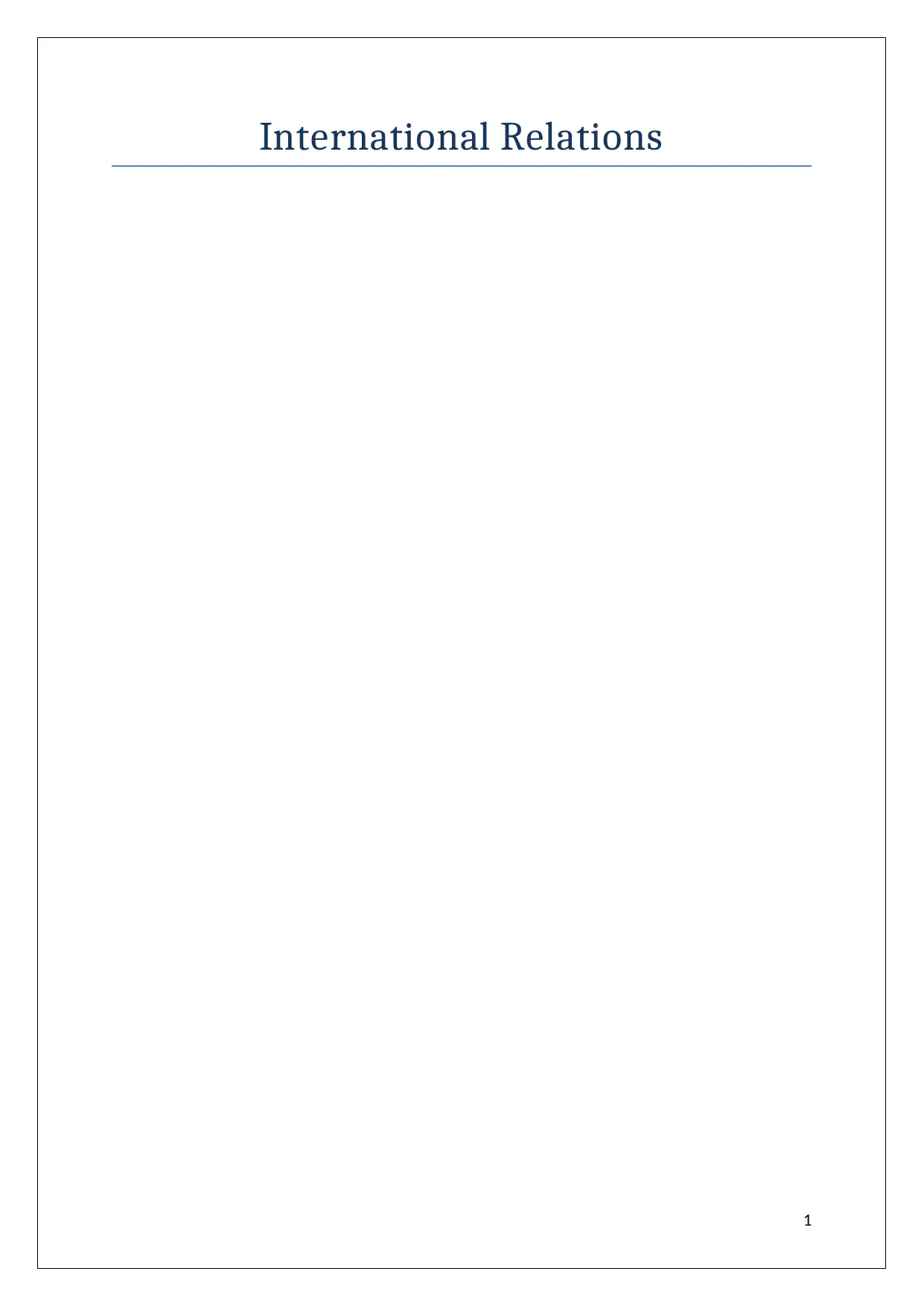
International Relations
1
1
Paraphrase This Document
Need a fresh take? Get an instant paraphrase of this document with our AI Paraphraser
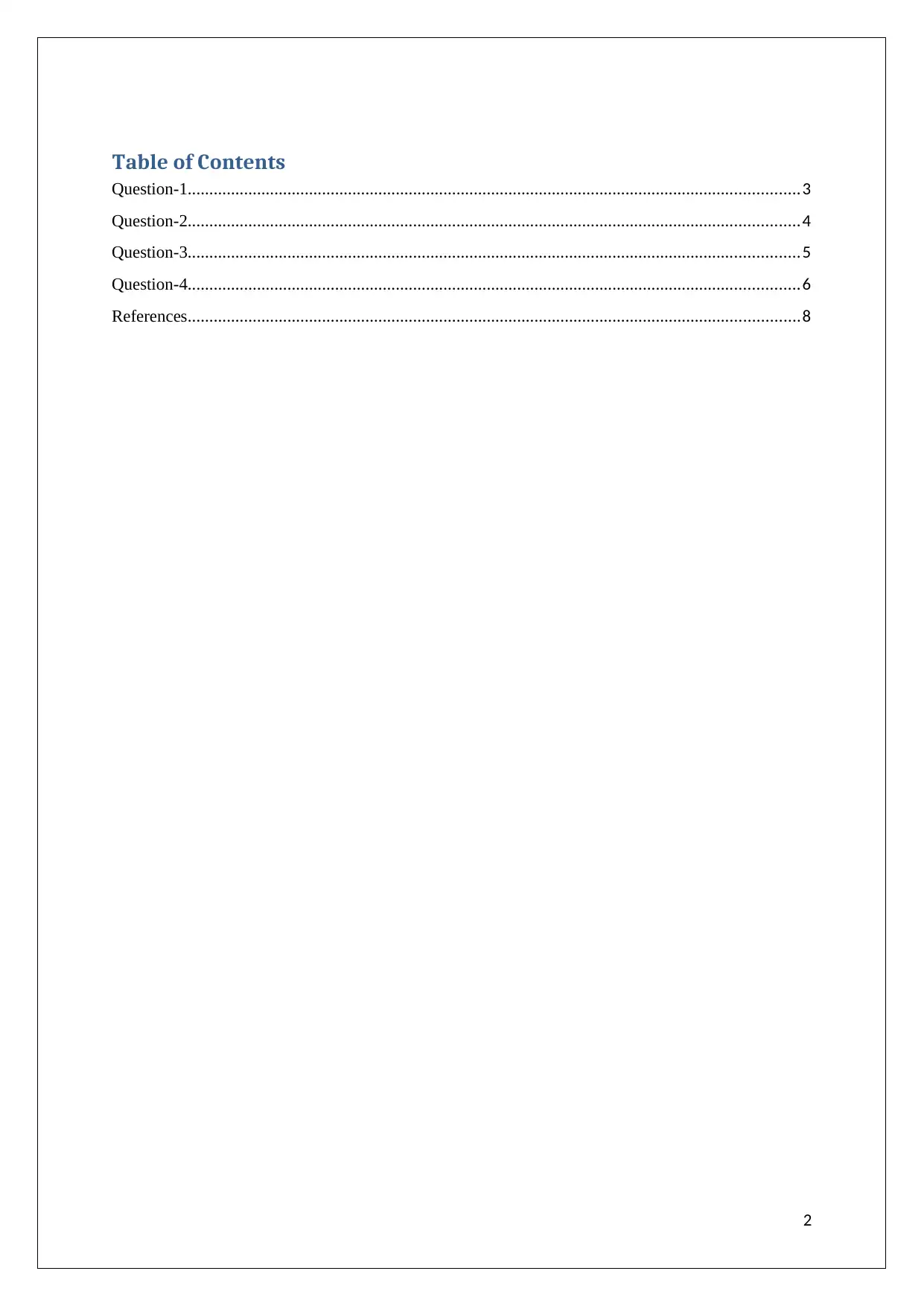
Table of Contents
Question-1.............................................................................................................................................3
Question-2.............................................................................................................................................4
Question-3.............................................................................................................................................5
Question-4.............................................................................................................................................6
References.............................................................................................................................................8
2
Question-1.............................................................................................................................................3
Question-2.............................................................................................................................................4
Question-3.............................................................................................................................................5
Question-4.............................................................................................................................................6
References.............................................................................................................................................8
2
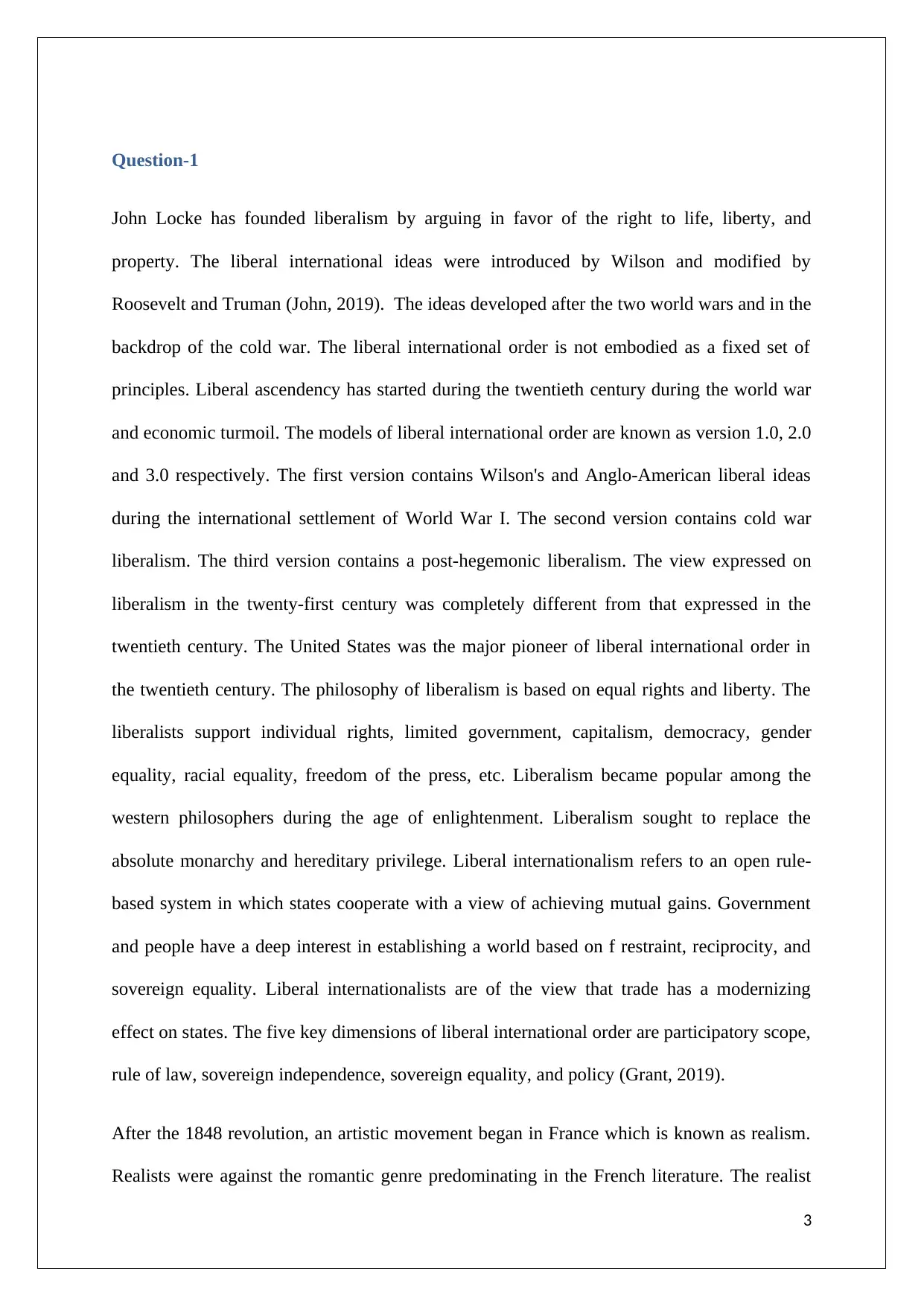
Question-1
John Locke has founded liberalism by arguing in favor of the right to life, liberty, and
property. The liberal international ideas were introduced by Wilson and modified by
Roosevelt and Truman (John, 2019). The ideas developed after the two world wars and in the
backdrop of the cold war. The liberal international order is not embodied as a fixed set of
principles. Liberal ascendency has started during the twentieth century during the world war
and economic turmoil. The models of liberal international order are known as version 1.0, 2.0
and 3.0 respectively. The first version contains Wilson's and Anglo-American liberal ideas
during the international settlement of World War I. The second version contains cold war
liberalism. The third version contains a post-hegemonic liberalism. The view expressed on
liberalism in the twenty-first century was completely different from that expressed in the
twentieth century. The United States was the major pioneer of liberal international order in
the twentieth century. The philosophy of liberalism is based on equal rights and liberty. The
liberalists support individual rights, limited government, capitalism, democracy, gender
equality, racial equality, freedom of the press, etc. Liberalism became popular among the
western philosophers during the age of enlightenment. Liberalism sought to replace the
absolute monarchy and hereditary privilege. Liberal internationalism refers to an open rule-
based system in which states cooperate with a view of achieving mutual gains. Government
and people have a deep interest in establishing a world based on f restraint, reciprocity, and
sovereign equality. Liberal internationalists are of the view that trade has a modernizing
effect on states. The five key dimensions of liberal international order are participatory scope,
rule of law, sovereign independence, sovereign equality, and policy (Grant, 2019).
After the 1848 revolution, an artistic movement began in France which is known as realism.
Realists were against the romantic genre predominating in the French literature. The realist
3
John Locke has founded liberalism by arguing in favor of the right to life, liberty, and
property. The liberal international ideas were introduced by Wilson and modified by
Roosevelt and Truman (John, 2019). The ideas developed after the two world wars and in the
backdrop of the cold war. The liberal international order is not embodied as a fixed set of
principles. Liberal ascendency has started during the twentieth century during the world war
and economic turmoil. The models of liberal international order are known as version 1.0, 2.0
and 3.0 respectively. The first version contains Wilson's and Anglo-American liberal ideas
during the international settlement of World War I. The second version contains cold war
liberalism. The third version contains a post-hegemonic liberalism. The view expressed on
liberalism in the twenty-first century was completely different from that expressed in the
twentieth century. The United States was the major pioneer of liberal international order in
the twentieth century. The philosophy of liberalism is based on equal rights and liberty. The
liberalists support individual rights, limited government, capitalism, democracy, gender
equality, racial equality, freedom of the press, etc. Liberalism became popular among the
western philosophers during the age of enlightenment. Liberalism sought to replace the
absolute monarchy and hereditary privilege. Liberal internationalism refers to an open rule-
based system in which states cooperate with a view of achieving mutual gains. Government
and people have a deep interest in establishing a world based on f restraint, reciprocity, and
sovereign equality. Liberal internationalists are of the view that trade has a modernizing
effect on states. The five key dimensions of liberal international order are participatory scope,
rule of law, sovereign independence, sovereign equality, and policy (Grant, 2019).
After the 1848 revolution, an artistic movement began in France which is known as realism.
Realists were against the romantic genre predominating in the French literature. The realist
3
⊘ This is a preview!⊘
Do you want full access?
Subscribe today to unlock all pages.

Trusted by 1+ million students worldwide
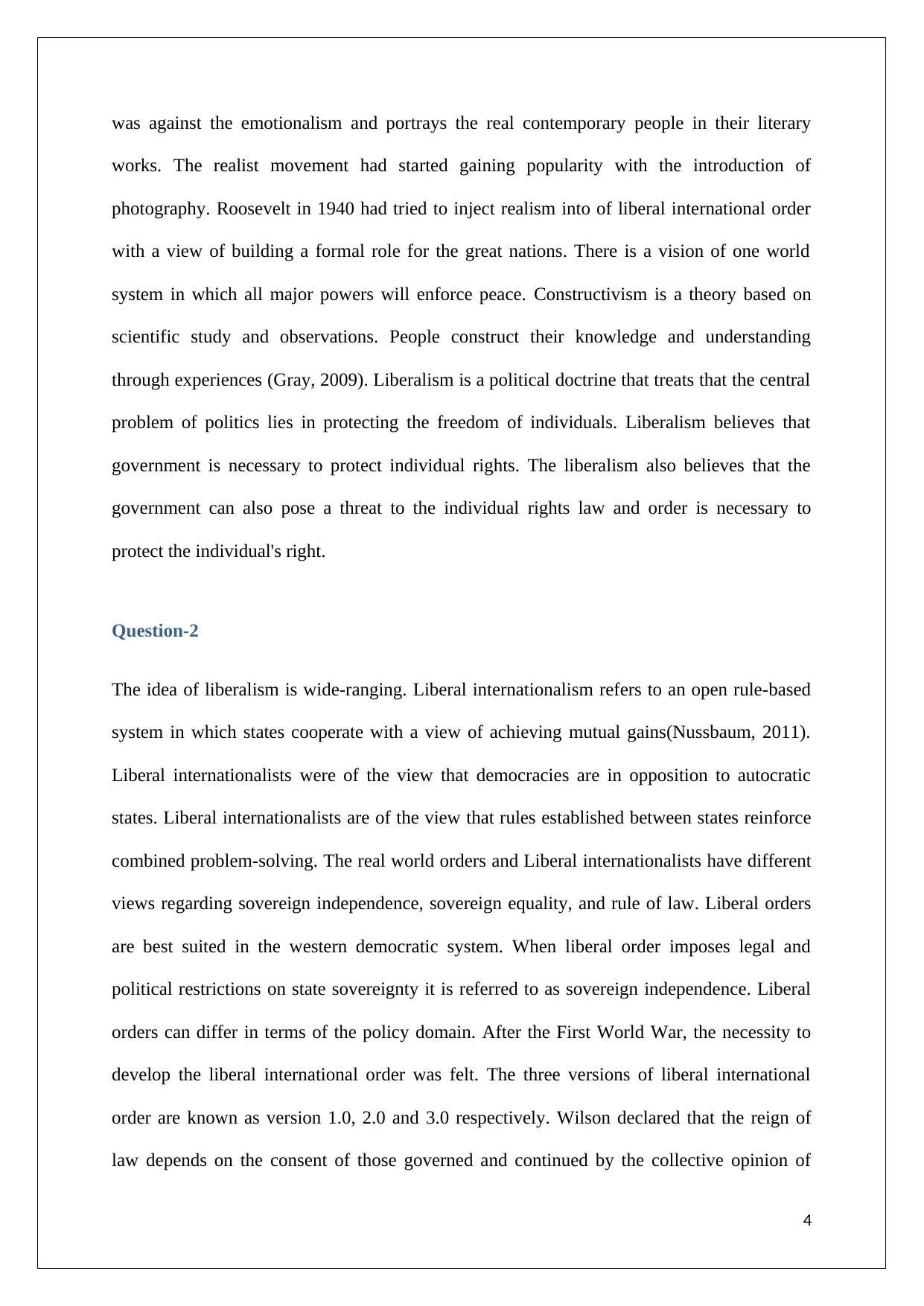
was against the emotionalism and portrays the real contemporary people in their literary
works. The realist movement had started gaining popularity with the introduction of
photography. Roosevelt in 1940 had tried to inject realism into of liberal international order
with a view of building a formal role for the great nations. There is a vision of one world
system in which all major powers will enforce peace. Constructivism is a theory based on
scientific study and observations. People construct their knowledge and understanding
through experiences (Gray, 2009). Liberalism is a political doctrine that treats that the central
problem of politics lies in protecting the freedom of individuals. Liberalism believes that
government is necessary to protect individual rights. The liberalism also believes that the
government can also pose a threat to the individual rights law and order is necessary to
protect the individual's right.
Question-2
The idea of liberalism is wide-ranging. Liberal internationalism refers to an open rule-based
system in which states cooperate with a view of achieving mutual gains(Nussbaum, 2011).
Liberal internationalists were of the view that democracies are in opposition to autocratic
states. Liberal internationalists are of the view that rules established between states reinforce
combined problem-solving. The real world orders and Liberal internationalists have different
views regarding sovereign independence, sovereign equality, and rule of law. Liberal orders
are best suited in the western democratic system. When liberal order imposes legal and
political restrictions on state sovereignty it is referred to as sovereign independence. Liberal
orders can differ in terms of the policy domain. After the First World War, the necessity to
develop the liberal international order was felt. The three versions of liberal international
order are known as version 1.0, 2.0 and 3.0 respectively. Wilson declared that the reign of
law depends on the consent of those governed and continued by the collective opinion of
4
works. The realist movement had started gaining popularity with the introduction of
photography. Roosevelt in 1940 had tried to inject realism into of liberal international order
with a view of building a formal role for the great nations. There is a vision of one world
system in which all major powers will enforce peace. Constructivism is a theory based on
scientific study and observations. People construct their knowledge and understanding
through experiences (Gray, 2009). Liberalism is a political doctrine that treats that the central
problem of politics lies in protecting the freedom of individuals. Liberalism believes that
government is necessary to protect individual rights. The liberalism also believes that the
government can also pose a threat to the individual rights law and order is necessary to
protect the individual's right.
Question-2
The idea of liberalism is wide-ranging. Liberal internationalism refers to an open rule-based
system in which states cooperate with a view of achieving mutual gains(Nussbaum, 2011).
Liberal internationalists were of the view that democracies are in opposition to autocratic
states. Liberal internationalists are of the view that rules established between states reinforce
combined problem-solving. The real world orders and Liberal internationalists have different
views regarding sovereign independence, sovereign equality, and rule of law. Liberal orders
are best suited in the western democratic system. When liberal order imposes legal and
political restrictions on state sovereignty it is referred to as sovereign independence. Liberal
orders can differ in terms of the policy domain. After the First World War, the necessity to
develop the liberal international order was felt. The three versions of liberal international
order are known as version 1.0, 2.0 and 3.0 respectively. Wilson declared that the reign of
law depends on the consent of those governed and continued by the collective opinion of
4
Paraphrase This Document
Need a fresh take? Get an instant paraphrase of this document with our AI Paraphraser
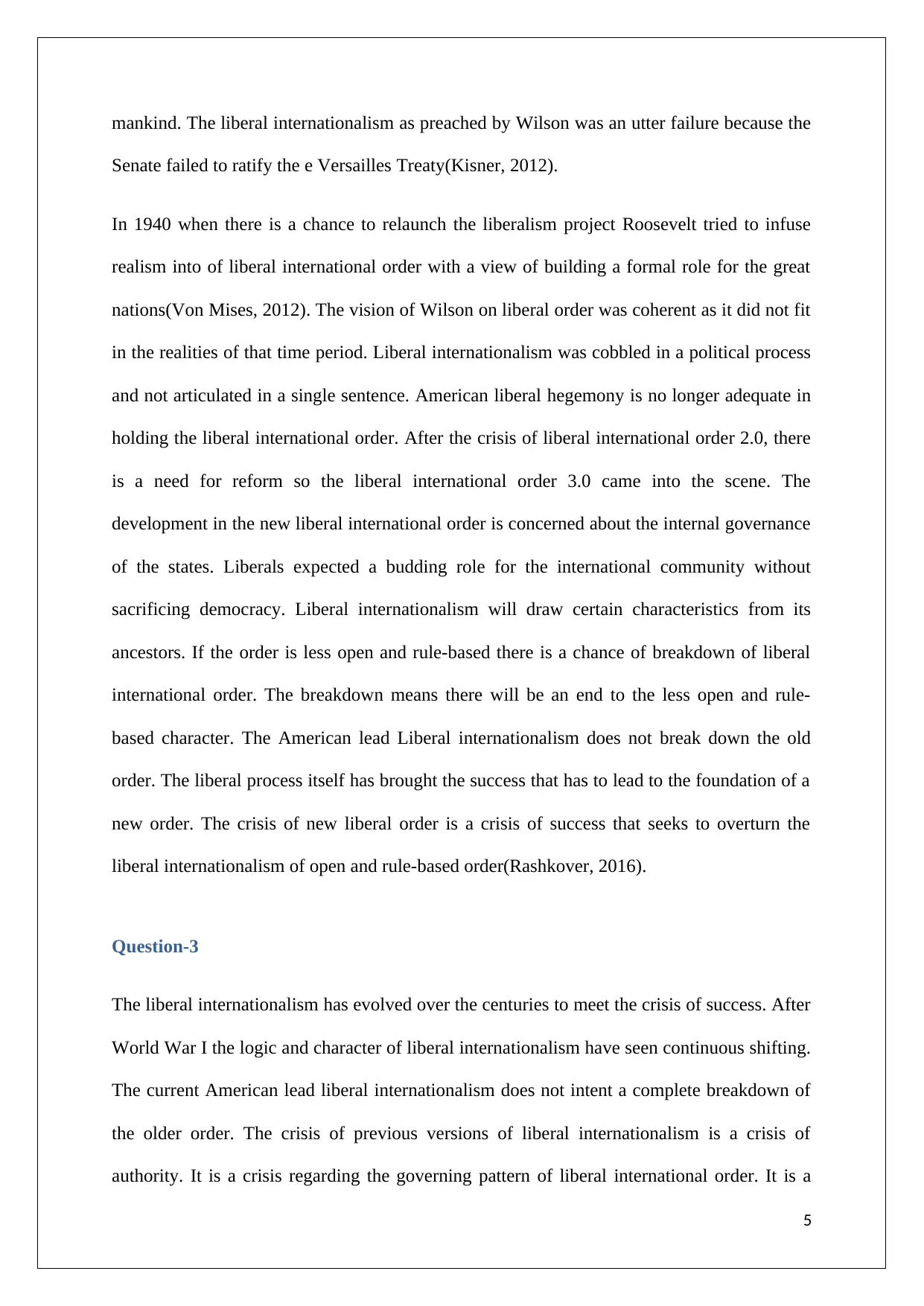
mankind. The liberal internationalism as preached by Wilson was an utter failure because the
Senate failed to ratify the e Versailles Treaty(Kisner, 2012).
In 1940 when there is a chance to relaunch the liberalism project Roosevelt tried to infuse
realism into of liberal international order with a view of building a formal role for the great
nations(Von Mises, 2012). The vision of Wilson on liberal order was coherent as it did not fit
in the realities of that time period. Liberal internationalism was cobbled in a political process
and not articulated in a single sentence. American liberal hegemony is no longer adequate in
holding the liberal international order. After the crisis of liberal international order 2.0, there
is a need for reform so the liberal international order 3.0 came into the scene. The
development in the new liberal international order is concerned about the internal governance
of the states. Liberals expected a budding role for the international community without
sacrificing democracy. Liberal internationalism will draw certain characteristics from its
ancestors. If the order is less open and rule-based there is a chance of breakdown of liberal
international order. The breakdown means there will be an end to the less open and rule-
based character. The American lead Liberal internationalism does not break down the old
order. The liberal process itself has brought the success that has to lead to the foundation of a
new order. The crisis of new liberal order is a crisis of success that seeks to overturn the
liberal internationalism of open and rule-based order(Rashkover, 2016).
Question-3
The liberal internationalism has evolved over the centuries to meet the crisis of success. After
World War I the logic and character of liberal internationalism have seen continuous shifting.
The current American lead liberal internationalism does not intent a complete breakdown of
the older order. The crisis of previous versions of liberal internationalism is a crisis of
authority. It is a crisis regarding the governing pattern of liberal international order. It is a
5
Senate failed to ratify the e Versailles Treaty(Kisner, 2012).
In 1940 when there is a chance to relaunch the liberalism project Roosevelt tried to infuse
realism into of liberal international order with a view of building a formal role for the great
nations(Von Mises, 2012). The vision of Wilson on liberal order was coherent as it did not fit
in the realities of that time period. Liberal internationalism was cobbled in a political process
and not articulated in a single sentence. American liberal hegemony is no longer adequate in
holding the liberal international order. After the crisis of liberal international order 2.0, there
is a need for reform so the liberal international order 3.0 came into the scene. The
development in the new liberal international order is concerned about the internal governance
of the states. Liberals expected a budding role for the international community without
sacrificing democracy. Liberal internationalism will draw certain characteristics from its
ancestors. If the order is less open and rule-based there is a chance of breakdown of liberal
international order. The breakdown means there will be an end to the less open and rule-
based character. The American lead Liberal internationalism does not break down the old
order. The liberal process itself has brought the success that has to lead to the foundation of a
new order. The crisis of new liberal order is a crisis of success that seeks to overturn the
liberal internationalism of open and rule-based order(Rashkover, 2016).
Question-3
The liberal internationalism has evolved over the centuries to meet the crisis of success. After
World War I the logic and character of liberal internationalism have seen continuous shifting.
The current American lead liberal internationalism does not intent a complete breakdown of
the older order. The crisis of previous versions of liberal internationalism is a crisis of
authority. It is a crisis regarding the governing pattern of liberal international order. It is a
5
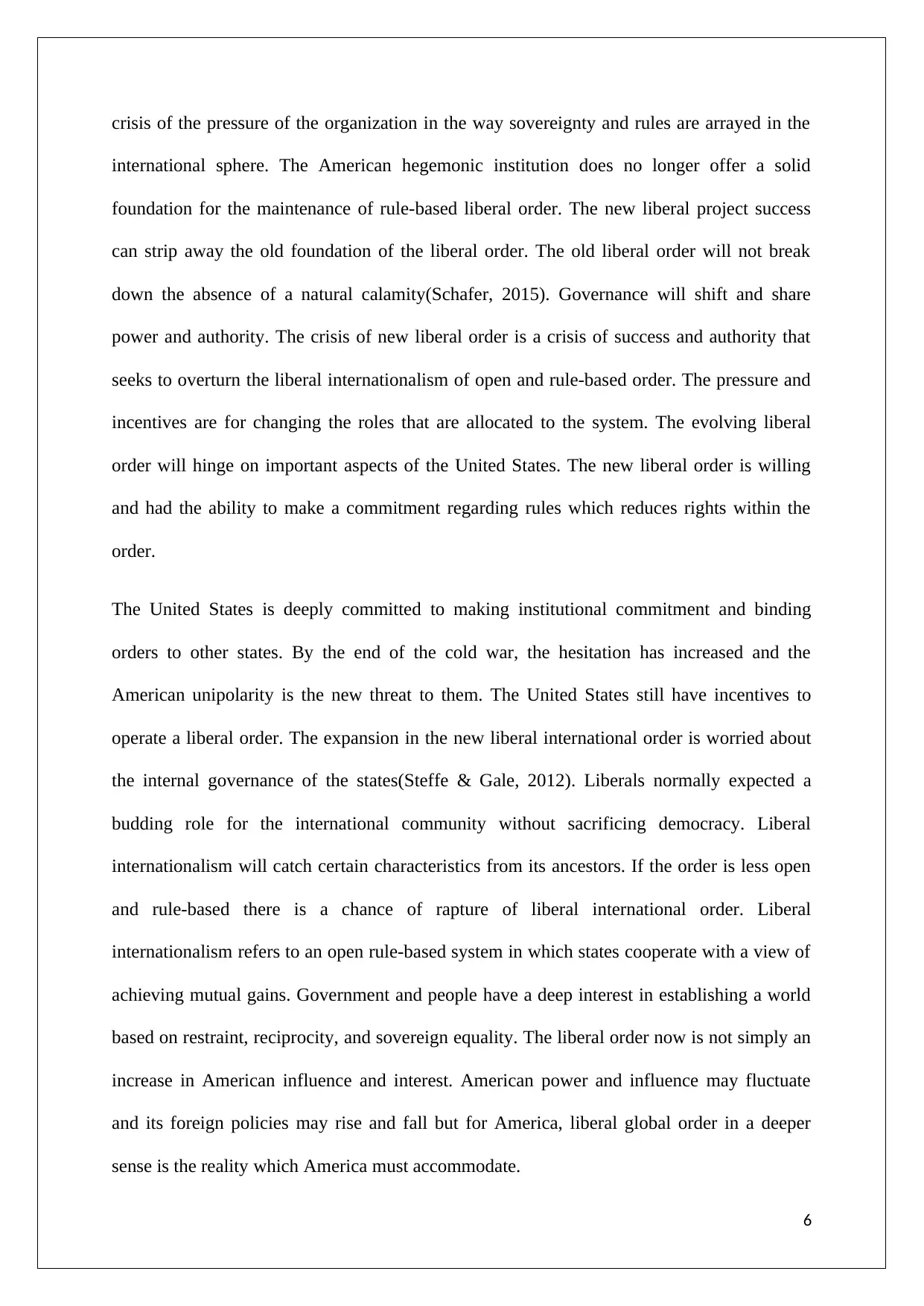
crisis of the pressure of the organization in the way sovereignty and rules are arrayed in the
international sphere. The American hegemonic institution does no longer offer a solid
foundation for the maintenance of rule-based liberal order. The new liberal project success
can strip away the old foundation of the liberal order. The old liberal order will not break
down the absence of a natural calamity(Schafer, 2015). Governance will shift and share
power and authority. The crisis of new liberal order is a crisis of success and authority that
seeks to overturn the liberal internationalism of open and rule-based order. The pressure and
incentives are for changing the roles that are allocated to the system. The evolving liberal
order will hinge on important aspects of the United States. The new liberal order is willing
and had the ability to make a commitment regarding rules which reduces rights within the
order.
The United States is deeply committed to making institutional commitment and binding
orders to other states. By the end of the cold war, the hesitation has increased and the
American unipolarity is the new threat to them. The United States still have incentives to
operate a liberal order. The expansion in the new liberal international order is worried about
the internal governance of the states(Steffe & Gale, 2012). Liberals normally expected a
budding role for the international community without sacrificing democracy. Liberal
internationalism will catch certain characteristics from its ancestors. If the order is less open
and rule-based there is a chance of rapture of liberal international order. Liberal
internationalism refers to an open rule-based system in which states cooperate with a view of
achieving mutual gains. Government and people have a deep interest in establishing a world
based on restraint, reciprocity, and sovereign equality. The liberal order now is not simply an
increase in American influence and interest. American power and influence may fluctuate
and its foreign policies may rise and fall but for America, liberal global order in a deeper
sense is the reality which America must accommodate.
6
international sphere. The American hegemonic institution does no longer offer a solid
foundation for the maintenance of rule-based liberal order. The new liberal project success
can strip away the old foundation of the liberal order. The old liberal order will not break
down the absence of a natural calamity(Schafer, 2015). Governance will shift and share
power and authority. The crisis of new liberal order is a crisis of success and authority that
seeks to overturn the liberal internationalism of open and rule-based order. The pressure and
incentives are for changing the roles that are allocated to the system. The evolving liberal
order will hinge on important aspects of the United States. The new liberal order is willing
and had the ability to make a commitment regarding rules which reduces rights within the
order.
The United States is deeply committed to making institutional commitment and binding
orders to other states. By the end of the cold war, the hesitation has increased and the
American unipolarity is the new threat to them. The United States still have incentives to
operate a liberal order. The expansion in the new liberal international order is worried about
the internal governance of the states(Steffe & Gale, 2012). Liberals normally expected a
budding role for the international community without sacrificing democracy. Liberal
internationalism will catch certain characteristics from its ancestors. If the order is less open
and rule-based there is a chance of rapture of liberal international order. Liberal
internationalism refers to an open rule-based system in which states cooperate with a view of
achieving mutual gains. Government and people have a deep interest in establishing a world
based on restraint, reciprocity, and sovereign equality. The liberal order now is not simply an
increase in American influence and interest. American power and influence may fluctuate
and its foreign policies may rise and fall but for America, liberal global order in a deeper
sense is the reality which America must accommodate.
6
⊘ This is a preview!⊘
Do you want full access?
Subscribe today to unlock all pages.

Trusted by 1+ million students worldwide
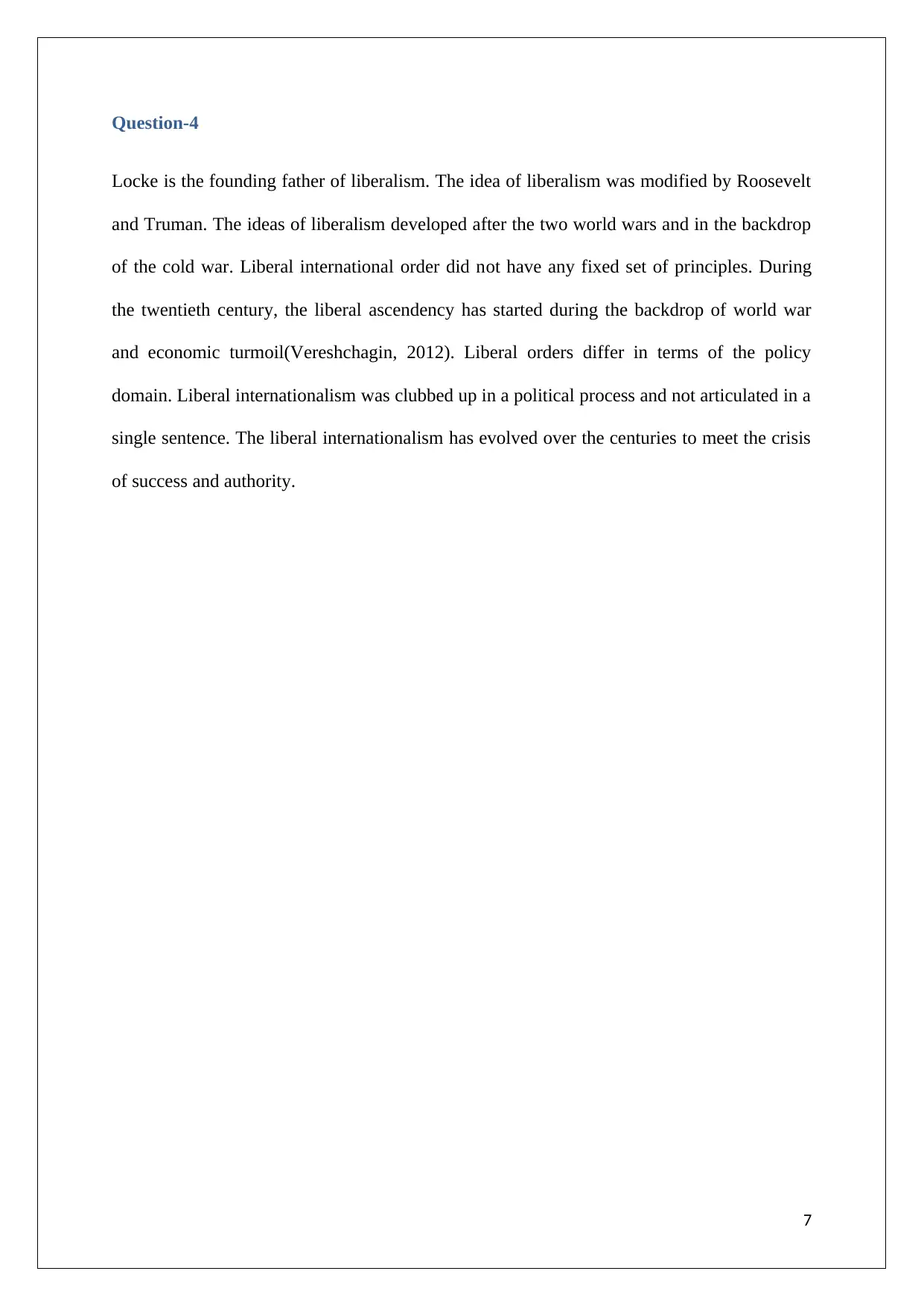
Question-4
Locke is the founding father of liberalism. The idea of liberalism was modified by Roosevelt
and Truman. The ideas of liberalism developed after the two world wars and in the backdrop
of the cold war. Liberal international order did not have any fixed set of principles. During
the twentieth century, the liberal ascendency has started during the backdrop of world war
and economic turmoil(Vereshchagin, 2012). Liberal orders differ in terms of the policy
domain. Liberal internationalism was clubbed up in a political process and not articulated in a
single sentence. The liberal internationalism has evolved over the centuries to meet the crisis
of success and authority.
7
Locke is the founding father of liberalism. The idea of liberalism was modified by Roosevelt
and Truman. The ideas of liberalism developed after the two world wars and in the backdrop
of the cold war. Liberal international order did not have any fixed set of principles. During
the twentieth century, the liberal ascendency has started during the backdrop of world war
and economic turmoil(Vereshchagin, 2012). Liberal orders differ in terms of the policy
domain. Liberal internationalism was clubbed up in a political process and not articulated in a
single sentence. The liberal internationalism has evolved over the centuries to meet the crisis
of success and authority.
7
Paraphrase This Document
Need a fresh take? Get an instant paraphrase of this document with our AI Paraphraser
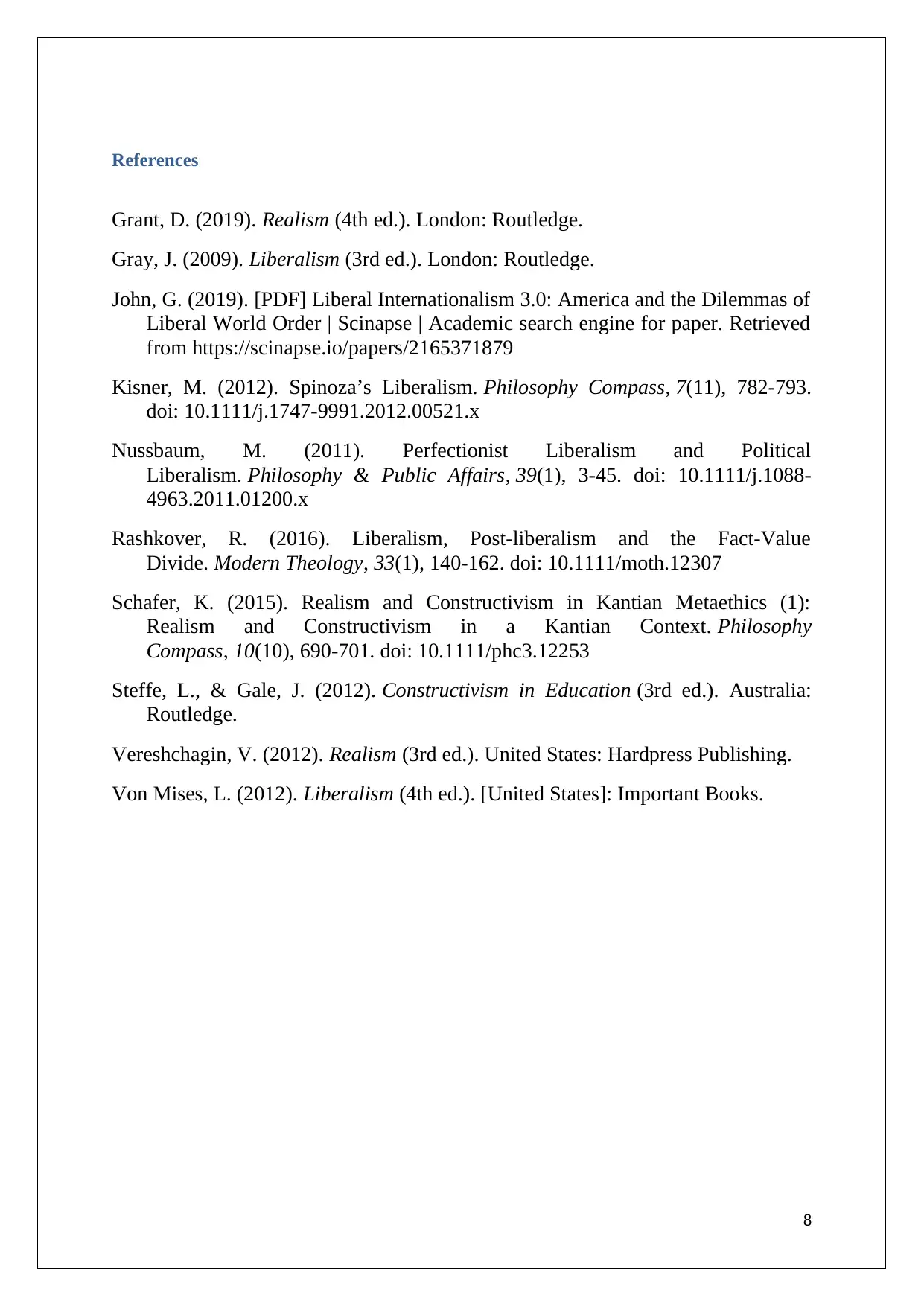
References
Grant, D. (2019). Realism (4th ed.). London: Routledge.
Gray, J. (2009). Liberalism (3rd ed.). London: Routledge.
John, G. (2019). [PDF] Liberal Internationalism 3.0: America and the Dilemmas of
Liberal World Order | Scinapse | Academic search engine for paper. Retrieved
from https://scinapse.io/papers/2165371879
Kisner, M. (2012). Spinoza’s Liberalism. Philosophy Compass, 7(11), 782-793.
doi: 10.1111/j.1747-9991.2012.00521.x
Nussbaum, M. (2011). Perfectionist Liberalism and Political
Liberalism. Philosophy & Public Affairs, 39(1), 3-45. doi: 10.1111/j.1088-
4963.2011.01200.x
Rashkover, R. (2016). Liberalism, Post-liberalism and the Fact-Value
Divide. Modern Theology, 33(1), 140-162. doi: 10.1111/moth.12307
Schafer, K. (2015). Realism and Constructivism in Kantian Metaethics (1):
Realism and Constructivism in a Kantian Context. Philosophy
Compass, 10(10), 690-701. doi: 10.1111/phc3.12253
Steffe, L., & Gale, J. (2012). Constructivism in Education (3rd ed.). Australia:
Routledge.
Vereshchagin, V. (2012). Realism (3rd ed.). United States: Hardpress Publishing.
Von Mises, L. (2012). Liberalism (4th ed.). [United States]: Important Books.
8
Grant, D. (2019). Realism (4th ed.). London: Routledge.
Gray, J. (2009). Liberalism (3rd ed.). London: Routledge.
John, G. (2019). [PDF] Liberal Internationalism 3.0: America and the Dilemmas of
Liberal World Order | Scinapse | Academic search engine for paper. Retrieved
from https://scinapse.io/papers/2165371879
Kisner, M. (2012). Spinoza’s Liberalism. Philosophy Compass, 7(11), 782-793.
doi: 10.1111/j.1747-9991.2012.00521.x
Nussbaum, M. (2011). Perfectionist Liberalism and Political
Liberalism. Philosophy & Public Affairs, 39(1), 3-45. doi: 10.1111/j.1088-
4963.2011.01200.x
Rashkover, R. (2016). Liberalism, Post-liberalism and the Fact-Value
Divide. Modern Theology, 33(1), 140-162. doi: 10.1111/moth.12307
Schafer, K. (2015). Realism and Constructivism in Kantian Metaethics (1):
Realism and Constructivism in a Kantian Context. Philosophy
Compass, 10(10), 690-701. doi: 10.1111/phc3.12253
Steffe, L., & Gale, J. (2012). Constructivism in Education (3rd ed.). Australia:
Routledge.
Vereshchagin, V. (2012). Realism (3rd ed.). United States: Hardpress Publishing.
Von Mises, L. (2012). Liberalism (4th ed.). [United States]: Important Books.
8
1 out of 8
Related Documents
Your All-in-One AI-Powered Toolkit for Academic Success.
+13062052269
info@desklib.com
Available 24*7 on WhatsApp / Email
![[object Object]](/_next/static/media/star-bottom.7253800d.svg)
Unlock your academic potential
Copyright © 2020–2025 A2Z Services. All Rights Reserved. Developed and managed by ZUCOL.





